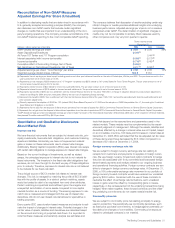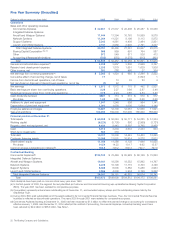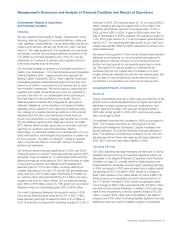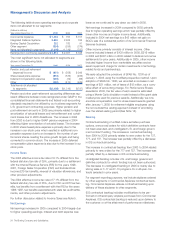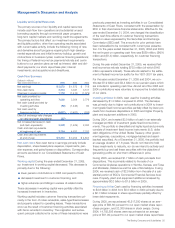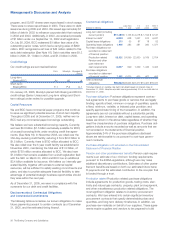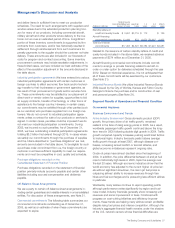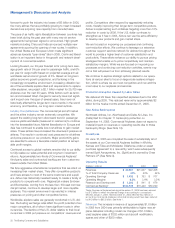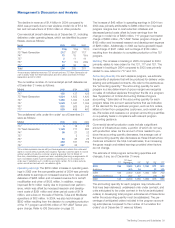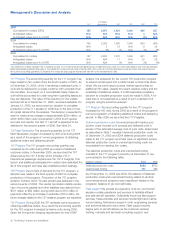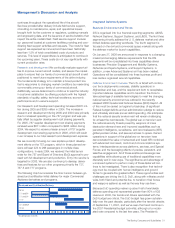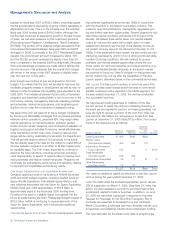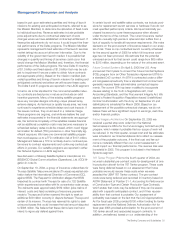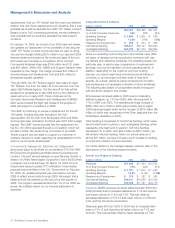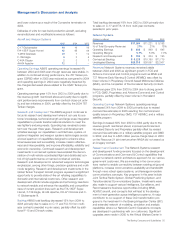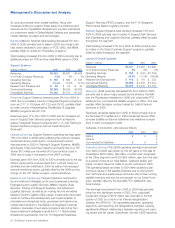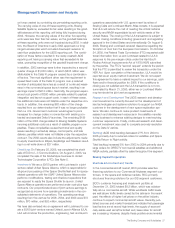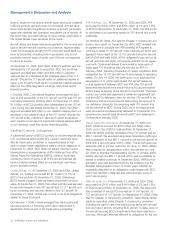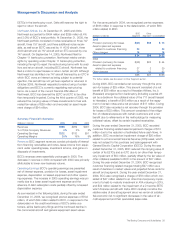Boeing 2005 Annual Report Download - page 31
Download and view the complete annual report
Please find page 31 of the 2005 Boeing annual report below. You can navigate through the pages in the report by either clicking on the pages listed below, or by using the keyword search tool below to find specific information within the annual report.
Management’s Discussion and Analysis
The decline in revenue of $1.4 billion in 2004 compared to
2003 was primarily due to new airplane model mix of $1.2 bil-
lion and net reductions of $132 million in other products.
Commercial jet aircraft deliveries as of December 31, including
deliveries under operating lease, which are identified by paren-
theses, were as follows:
Model 2005 2004 2003
717 13(5) 12(6) 12(11)
737 Next-Generation 212* 202* 173*
747 13 15 19(1)
757 2 11 14
767 10* 9(1) 24(5)
777 40 36 39
Total 290 285 281
*Intracompany deliveries were two 767 aircraft and two 737 Next Generation air-
craft in 2005, three 737 Next-Generation aircraft in 2004 and three 737 Next-
Generation aircraft in 2003
The cumulative number of commercial jet aircraft deliveries as
of December 31 were as follows:
Model 2005 2004 2003
717 150 137 125
737 Next-Generation 1,834 1,622 1,420
747 1,366 1,353 1,338
757 1,049 1,047 1,036
767 935 925 916
777 539 499 463
The undelivered units under firm order* as of December 31
were as follows:
Model 2005 2004 2003
717 5 18 22
737 Next-Generation 1,123 771 800
747 58 27 32
757 2 13
767 30 25 25
777 288 167 159
787 287 52
*Firm orders represent new aircraft purchase agreements where the customers’
rights to cancel without penalty have expired. Typically customer rights to cancel
without penalty include the customer receiving approval from its Board of
Directors, shareholders, government and completing financing arrangements. All
such cancellation rights must be satisfied or expired prior to recording a firm
order even if satisfying such conditions are highly certain. Firm orders exclude
option aircraft and aircraft with cancellation rights.
Operating earnings The $679 million increase in operating earn-
ings in 2005 over the comparable period of 2004 was primarily
attributable to earnings on increased revenue from new aircraft
deliveries of $265 million and increased revenue from aircraft
modification and other of $128 million. In addition, margin
improved $414 million mainly due to improved cost perform-
ance, which was offset by increased research and develop-
ment costs of $361 million and other period costs of $174
million, and a loss on the sale of Wichita, Tulsa and McAlester
operations of $68 million. In 2004, we also had charges of
$280 million resulting from the decision to complete production
of the 717 program and $195 million of 767 USAF Tanker pro-
gram charge. Refer to IDS Discussion on page 33.
The increase of $46 million in operating earnings in 2004 from
2003 was primarily attributable to $466 million from improved
program margins due to cost reduction initiatives and
decreased period costs offset by lower earnings from the
change in model mix of $205 million, 717 program termination
charge of $280 million, 767 USAF Tanker program charge of
$195 million and increased research and development expense
of $265 million. Additionally, in 2003 we had a goodwill impair-
ment charge of $341 million and a charge of $184 million
resulting from the decision to complete production of the 757
program.
Backlog The increase in backlog in 2005 compared to 2004
primarily relates to new orders for the 737, 777 and 787. The
increase in backlog in 2004 compared to 2003 was primarily
related to new orders for 777 and 787.
Accounting Quantity For each airplane program, we estimate
the quantity of airplanes that will be produced for delivery under
existing and anticipated contracts. We refer to this estimate as
the “accounting quantity.” The accounting quantity for each
program is a key determinant of gross margins we recognize
on sales of individual airplanes throughout the life of a program.
See “Application of Critical Accounting Policies-Program
accounting.” Estimation of the accounting quantity for each
program takes into account several factors that are indicative
of the demand for the particular program, such as firm orders,
letters of intent from prospective customers, and market stud-
ies. We review and reassess our program accounting quantities
on a quarterly basis in compliance with relevant program
accounting guidance.
Commercial aircraft production costs include a significant
amount of infrastructure costs, a portion of which do not vary
with production rates. As the amount of time needed to pro-
duce the accounting quantity decreases, the average cost of
the accounting quantity also decreases as these infrastructure
costs are included in the total cost estimates, thus increasing
the gross margin and related earnings provided other factors
do not change.
The estimate of total program accounting quantities and
changes, if any, as of December 31 were:
737 Next-
717 Generation 747 757 767 777
2005 156 2,800 1,424 1,050 971 800
Additions 400 24 12 100
2004 156 2,400 1,400 1,050 959 700
Additions/(deletions) 8 200 12 (16) 50
2003 148 2,200 1,388 1,050 975 650
The accounting quantity for each program may include units
that have been delivered, undelivered units under contract, and
units anticipated to be under contract in the future (anticipated
orders). In developing total program estimates all of these items
within the accounting quantity must be addressed. The per-
centage of anticipated orders included in the program account-
ing estimates as compared to the number of cumulative firm
orders* as of December 31 were as follows:
The Boeing Company and Subsidiaries 29




